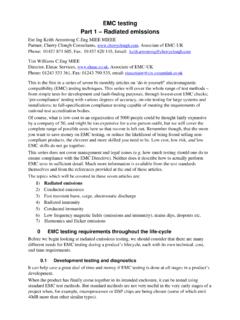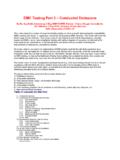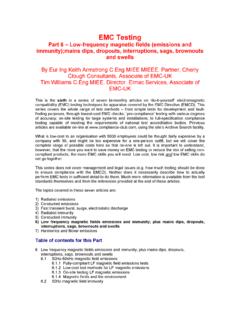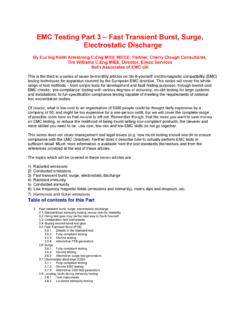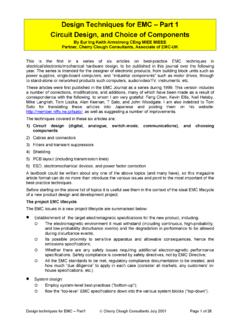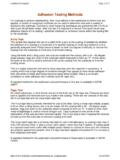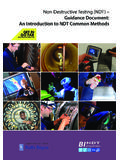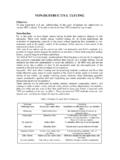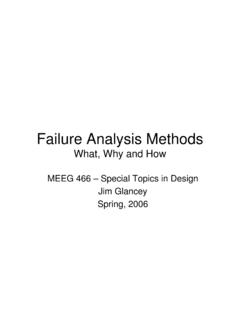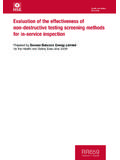Transcription of EMC Testing Part 5 - compliance-club.com
1 EMC Testing part 5 Conducted Immunity By Eur Ing Keith Armstrong MIEE MIEEE, Partner, Cherry Clough Consultants, Associate of EMC-UK Tim Williams MIEE, Director, Elmac Services, Associate of EMC-UK This is the fifth in a series of seven bi-monthly articles on do-it-yourself electromagnetic compatibility (EMC) Testing techniques for apparatus covered by the EMC Directive (EMCD). This series covers the whole range of test methods from simple tests for development and fault-finding purposes, through lowest-cost EMC checks; pre-compliance Testing with various degrees of accuracy; on-site Testing for large systems and installations; to full-specification compliance Testing capable of meeting the requirements of national test accreditation bodies. Previous articles are available on-line at , using the site s Archive Search facility.
2 What is low-cost to an organisation with 5000 employees could be thought fairly expensive by a company with 50, and might be too expensive for a one-person outfit, but we will cover the complete range of possible costs here so that no-one is left out. It is important to understand, however, that the more you want to save money on EMC Testing or reduce the risk of selling non-compliant products, the more EMC skills you will need. Low cost, low risk and low EMC skills do not go together. This series does not cover management and legal issues ( how much Testing should be done to ensure compliance with the EMCD). Neither does it necessarily describe how to actually perform EMC tests in sufficient detail to do them. Much more information is available from the test standards themselves and from the references provided at the end of these articles.
3 The topics covered in these seven articles are: 1) Radiated emissions 2) Conducted emissions 3) Fast transient burst, surge, electrostatic discharge 4) Radiated immunity 5) Conducted immunity 6) Low frequency magnetic fields (emissions and immunity), mains dips, dropouts,etc 7) Harmonics and flicker emissions Table of contents for this part 5 Conducted RF immunity Non-CE issues with immunity Testing Introduction to conducted immunity Testing Injecting a reasonably accurate RF voltage (or current) Preventing leakage The non-linear sensitivity of analogue and digital semiconductors to RF. Determining an engineering margin Monitoring the EUT to be able to tell when its performance has degraded too much. Alternative transducers and test methods [unnecessary repetition] Close-field probes Voltage injection probe Crosstalk injection techniques Licensed radio transmitters Bulk Current Injection (BCI)
4 Direct injection with a CDN The EM Clamp General notes on test set-ups Signal generators and power amplifiers Alternative types of signal generator RF Power Amplifiers Correlating alternative test methods with EN 61000-4-6 On-site Testing Full compliance conducted RF immunity Testing Generator Transducers Calibration and levels Test setup References 5 Conducted RF immunity part 0 of this series [1] described the various types of EMC tests that could be carried out, including: Development Testing and diagnostics (to save time and money) Pre-compliance Testing (to save time and money) Full compliance Testing Troubleshooting to quickly identify and fix problems with compliance tests, or with interference in the field QA Testing (to ensure continuing compliance in volume manufacture) Testing of changes and variants (to ensure continuing compliance).
5 And part 0 also described how to get the best value when using a third-party test laboratory [1]. This part of the series focuses on Testing continuous conducted radio-frequency (RF) immunity, sometimes called conducted electromagnetic susceptibility (EMS) to the EN standards for typical domestic / commercial / industrial environments. Other kinds of immunity tests may be required for automotive, aerospace, space, rail, marine and military environments. Over the years these, and other industries, have often developed their own immunity test standards based on their own particular kinds of disturbances, usually for reliability reasons. IMPORTANT SAFETY NOTE: Some of these tests involve electrical hazards, particularly the outputs from RF power amplifiers and the cables, connectors and transducers connected to them, and transducers which make direct connection to the mains supply or other hazardous conductors.
6 Also, performing some of these tests outside a shielded room could create interference problems for other equipment, possibly interfering with aircraft communications, navigational radio beacons, or automatic landing systems so could have safety implications. These tests can be dangerous, and all appropriate safety precautions must be taken. If you don t know what safety precautions to take, ask a competent person. The basic EN test methods described here are identical to the basic IEC test methods ( EN 61000-4-6 = IEC 61000-4-6), so this article may also be of use where non-EU EMC requirements apply. Non-CE issues with immunity Testing See part 4 of this series [2] for more detail on the following important issues for immunity Testing : Saving costs by early EMC Testing (section ). Immunity Testing for reliability and functional safety (section ).
7 Introduction to conducted immunity Testing Continuous conducted RF immunity Testing involves injecting RF voltages or currents into each of the cables associated with the equipment under test (EUT). The purpose of the test is to simulate the proximity of the EUT and its connected cables to radio transmitters and RF manufacturing equipment operating at low frequencies. These frequencies are not easy to test using the radiated RF immunity techniques described in [2]. It is hard to generate uniform fields in typical test facilities at frequencies much below 80 MHz, but for typical sizes of apparatus the immunity problems at frequencies below 80 MHz are normally associated with cable coupling, so conducted Testing of the cables is seen as a reasonable alternative to radiated methods at such frequencies. Conducted RF immunity Testing is also a lot less costly to do properly than radiated RF immunity, and complete systems for full-compliance Testing can be purchased for under 15,000.
8 EN 61000-4-6 [3] is the basic EMC test method for conducted RF immunity called-up by the latest editions of harmonised product or generic immunity test standards. Alternative conducted test methods described here should always follow the methodology of [3] as far as is practical to help make compliant products. For small products [3] considers it acceptable to use its conducted tests over the range 150kHz to 230 MHz, but for larger products the range is 150kHz to 80 MHz. Small products with short cables may not need to be tested to as low a frequency as 150kHz. See Annex B of [3] for more on frequency ranges versus EUT dimensions. But remember that it will be the relevant EMCD harmonised standard (product or generic) that specifies the frequency range and test levels for a given type of EUT. In general, when self-declaring conformity to the EMCD using the standards route you will not be able to choose your own frequency ranges.
9 A lack in [3] is that it only injects common-mode RF and does not test differential-mode RF even though it can exist on mains and other types of cables. Differential-mode RF noise is mostly an issue at frequencies under 10 MHz, especially when switch-mode power converters and other noisy technologies are powered from the same mains distribution as the product concerned. A lack in most of the conducted RF test methods is that in real life all the cables associated with a product will be exposed to varying amounts of RF conducted noise simultaneously, but the test methods only inject into one cable at a time. Clearly, it is possible for different interactions to occur when more than one cable has RF on it and in real life the frequencies on different cables can be different and so cause cross-modulation effects which cannot be simulated by single-frequency Testing so this is a weakness in any of the standardised conducted test methods.
10 However it is possible to vary the test methods described here to test for differential-mode immunity, and also to test multiple cables at the same time with the same or different RF stimuli, to help ensure reliability in real applications. There are five main issues in radiated RF immunity Testing which are of concern for all the test methods discussed here: Injecting a reasonably accurate RF voltage (or current) into the EUT s cables. Preventing the tests from leaking and possibly causing interference. The non-linear sensitivity of analogue and digital semiconductors to RF. Determining a reasonable engineering margin . Monitoring the EUT to be able to tell when its performance has degraded too much. It will help if we discuss these issues before moving on to describe the test methods themselves. Injecting a reasonably accurate RF voltage (or current) [3] describes how to perform a level-setting procedure (calibration) for each of the three types of test transducers it employs: Direct voltage injection using coupling-decoupling networks (CDNs).
